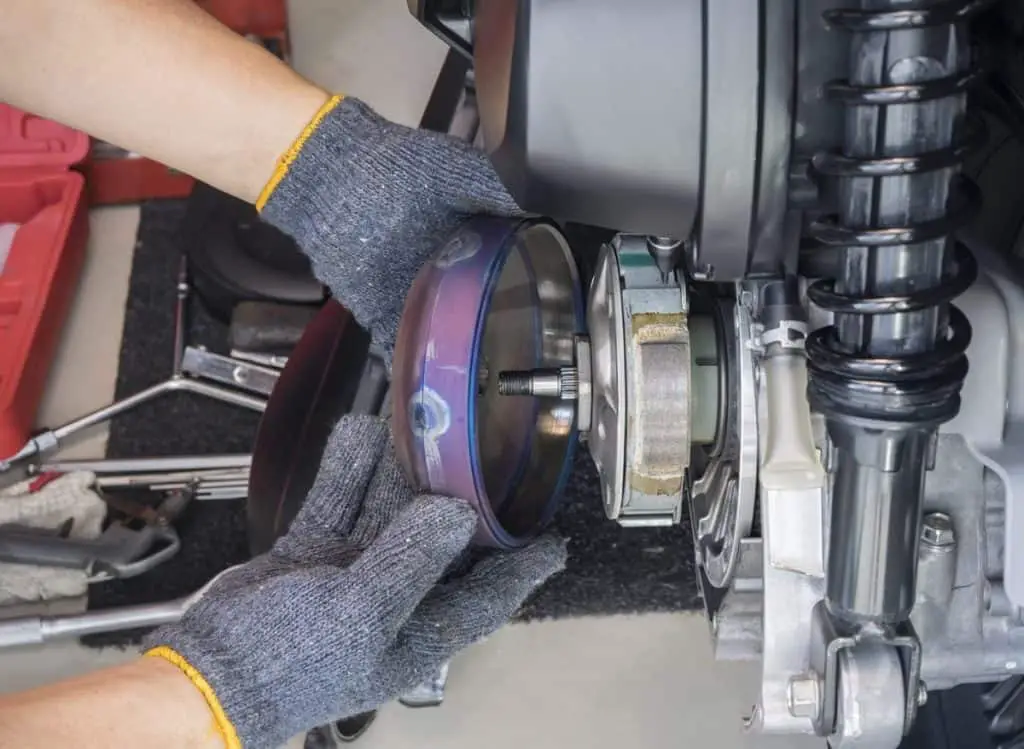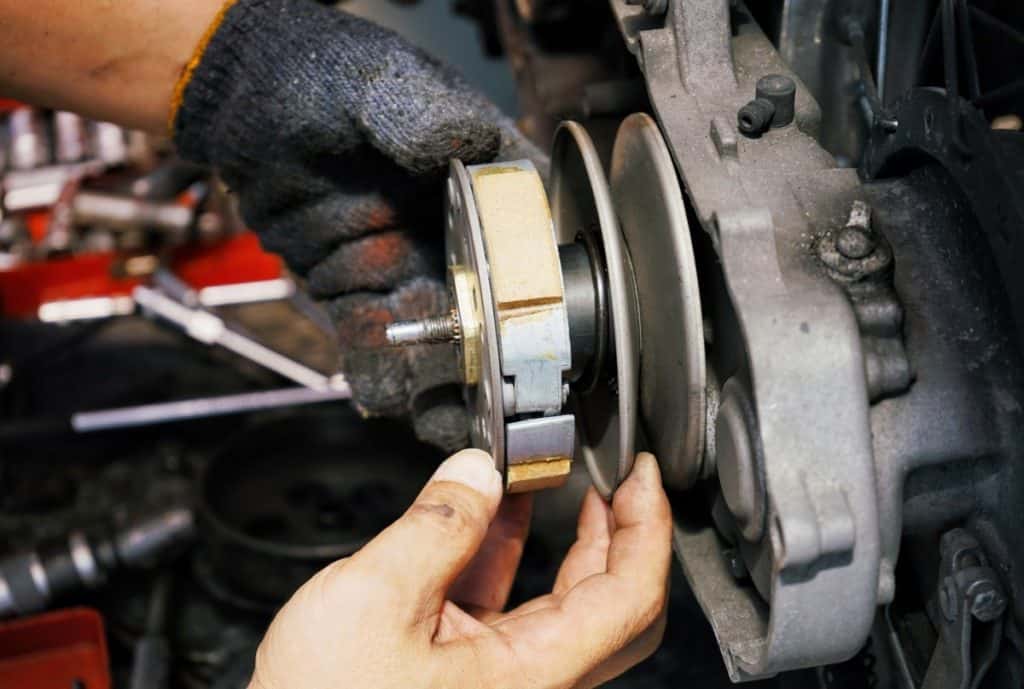A clutch is typically just called a clutch. But if you’ve ever gone to change the oil on your ATV you will have noticed that the type of oil you should use differs because some ATVs have what is called a wet clutch. So, today I’ll explain what a wet clutch on an ATV is.
A wet clutch on an ATV functions virtually the same as a dry clutch also just called a clutch. The main difference is a wet clutch is coated in oil and is self-contained to keep the oil in. This causes the engine to run quieter, the clutch to last longer, and have smoother gear changes.
However, there are some advantages that a dry clutch has over a wet clutch. The noise level of engines is ideally kept to a minimum, and for that reason, wet clutches are typically used exclusively on all new vehicles. Below, I will describe the pros and cons of each, how they work, and how to tell if you have a wet clutch on your ATV.

Why Wet Clutches Are Used Instead of Dry Clutches
There are various benefits of wet clutches over dry clutches. But, there are also benefits to dry clutches. The main advantage of a wet clutch is that it lasts longer than a dry clutch. This is because the oil in a wet clutch produces less wear and tear on the individual parts that make up a clutch.
Here’s a table that shows the pros of a wet clutch and a dry clutch:
| Wet Clutch | Dry Clutch |
|---|---|
| Quite | Oil doesn’t get dirty as fast |
| Lasts a long time | More grab on the gears – more precision |
| Smooth gear transitions | No oil drag – increased performance |
| The clutch doesn’t get as hot | Easier to work on |
And here’s a table that shows the disadvantages of a wet clutch and dry clutch:
| Wet Clutch | Dry Clutch |
|---|---|
| Oil drag – decreased performance | Doesn’t last as long before it needs replacing |
| Doesn’t sound as good (subjective) | Clutch gets hotter |
| Oil gets dirtier faster | The gear transitions are jumpier |
| Harder to access the clutch to work on it | Much louder |
A wet clutch contains oil that coats all of the components. When you change gear it feels a lot smoother. However, this smoothness comes at a cost. There is what is called oil draw, this is a slight decrease in performance because of the delay between when the gear is changed and when it changes.
Although, this delay is on the order of microseconds this is very important in moto-GP racing. In racing, every second counts, and a very small time difference can make the difference between getting into a position where you can pass another driver or not. Each delay in changing gears adds up and in the end, can add significant time to the overall finish time in a race. This is why in motorcycle racing all motorbikes use a dry clutch.
But, the minor differences in performance are not much of a factor for utility and recreation ATVs, as well as, other vehicles.
When the clutch is released on a dry clutch is has more grab to it. This makes the vehicle jump forward more and is more difficult to create a smooth transition as you change gears. This makes driving a wet clutch more comfortable.
A wet clutch is fully enclosed to keep in the oil. Whereas, most dry clutches are open so that the wind can help cool them. This means when the clutch needs to be changed or repaired a dry clutch is much easier to access.
Because the individual cogs and components inside a wet clutch are lubricated it’s less noisy than a dry clutch. Certain people love the sound of an engine. However, for the most part, it’s a nuisance. Now, because wet clutches are available it makes more sense to have one as it reduces the overall noise on roadways, making surrounding homes and buildings quieter and more peaceful.

The oil from the engine and the transmission (clutch) goes through the same oil filter. Therefore, the oil filter gets dirtier quicker than on a dry clutch engine. Regardless of this fact, the amount of time in between each oil change is still fairly reasonable.
I explained this in detail in this article about how often you need to change the oil on an ATV, it covers on average how often an oil change and oil filter change needs to be done based on the user manuals of the most popular ATV brands such as Polaris, Yamaha, and Honda.
How Does an ATV Wet Clutch Work?
A clutch on a car and motorbikes like ATVs and four-wheelers is generally just called a clutch. However, there are both wet and dry clutches. So, here’s how a wet clutch works and how it differs from a dry clutch.
An ATV wet clutch works exactly the same as a dry clutch except that it’s fully enclosed, and it’s coated in engine oil rather than operating completely dry like a dry clutch. The design and function are exactly the same other than minor differences due to needing to house and contain engine oil.
Wet and dry clutches have two sets of rotating discs. They engage and disengage when the clutch is squeezed and released, and then a central pin moves the discs forwards and backwards which controls what gear the ATV is in.
Here’s a short video that shows how a wet clutch works. However, a dry clutch works in virtually the same way:
How To Know if Your ATV Has a Wet Clutch?
Vehicles can have either a wet or a dry clutch. Wet clutches are by far much more common on ATVs. But, it’s important to know whether your ATV has a wet clutch or not. So, here’s how to tell.
Virtually all ATVs have a wet clutch. But, it does differ by make and model. Provided you use the recommended type of oil in your ATV owner’s manual you won’t do any damage to your clutch, whether it’s wet or dry because the engine and wet clutch get engine oil from the same oil tank.
It’s best to refer to your owner’s manual to see the exact they recommend – it’s typically 10W – 40. And they will give the JASO or API number, which will be API – SG, SH, SJ, SL, SM, or SN. For the JASO standard, it will typically be MA (MA1, MA2).
JASO and API are two different standards for oil, and you can use one or the other. However, sometimes both are given for the engine oil. There is a lot of difference between oils of different API or JASO standards. Youth ATVs and full-sized ATVs have different recommended engine oil.
Therefore, it’s always best to see what the recommended engine oil is in the owner’s manual. Virtually all owner’s manuals are available for free as a PDF on the official website for your ATV. This is based on looking through the owner’s manuals of the most popular brands such as Yamaha, Polaris, Kawasaki, and Honda.

